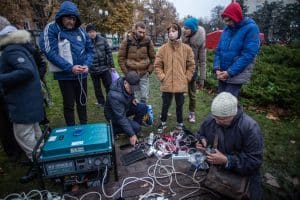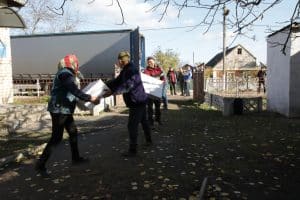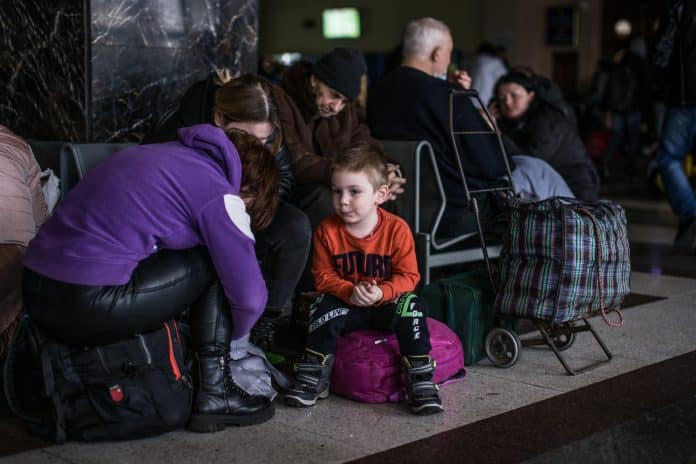It’s now one year since the Russian Federation’s 24 February invasion of Ukraine. That’s one year of unimaginable suffering, loss and destruction. And one year in which the life of every single woman, man and child in Ukraine has been torn apart.
Thousands of civilians – including children – have been killed, injured and traumatized. Livelihoods have been devastated and entire cities are in ruins.
But despite all this, the people of Ukraine have continually showed the world their incredible sense of solidarity and resilience. They came together to support one another, created thousands of groups of volunteers, and went to the front lines to make sure people trapped could get the support they needed. Humanitarian organizations complemented this effort alongside the incredible support and solidarity from the international community and citizens of every country who stepped in to support Ukraine.
Together, we helped 16 million people in Ukraine last year.
But one year on, the war is far from over.
Here are 7 reasons why the world must keep supporting the humanitarian response in Ukraine.
1. 18 million people need humanitarian assistance
When Russia invaded Ukraine on 24 February, it dramatically escalated a conflict that had been ravaging the east of the country since 2014.
Just a few weeks after the full-scale war began, the number of people who needed humanitarian assistance jumped from just below 3 million to almost 18 million.
Today, those people still face life-threatening needs.
2. Millions had to flee for their lives and try to settle far from home
The war caused a grave displacement crisis not seen in recent history. In the first few months after the invasion, nearly 8 million people were internally displaced in Ukraine. The same number of people fled across borders, leaving behind their families, homes, belongings and jobs.
Since then, the displacement crisis has only continued. Almost 5.5 million people returned to their places of origin, and millions more continue to flee from the east.
Today, more than 5.5 million people are still internally displaced in Ukraine, and almost 8 million people are refugees.
3. Access to health care, water and electricity is now decimated

Last year, almost 70 per cent of attacks on health-care facilities around the world took place in Ukraine, according to the World Health Organization (WHO). The country’s hospitals were bombed when people needed them the most, and access to essential health-care services is now decimated, particularly in the east.
But it doesn’t stop there. The war has devastated Ukraine’s water system. Millions of people now struggle every day to have safe drinking water, and others are forced to rely on unsafe water sources. The situation is extreme in areas close to both sides of the front line, where some people have now endured an entire year without piped water. This problem began much earlier in Russian-controlled Donetsk.

An energy crisis followed the repeated attacks on Ukraine’s infrastructure, in October 2022, which added new dimensions to the humanitarian crisis. Hospitals can’t operate without electricity, water can’t be pumped and people can’t heat their homes in the middle of a harsh winter.
Ukraine needs support to keep its hospitals functioning, and to ensure people have drinking water and other essential services.
4. Access to education is at risk

When Russian forces invaded Bucha, Mykhailo was teaching at the locality’s public school. But he decided to stay inside the school to protect it.
Throughout the year, Ukraine’s schools and classrooms have been attacked, destroyed or converted into military bases, severely hampering access to education. Almost 40 per cent of schools in Ukraine must rely on online learning, but even that is now disrupted due to compromised access to electricity and the Internet.

Schools that have been preserved still face tremendous challenges, as they are affected by the energy crisis and repeated air raids. Children now spend hour after hour in basements or bunkers when they should be at school.
In Ukraine, 5.3 million children need support to ensure they can continue their education.
5. People are dealing with unimaginable trauma
The war is leaving deep, invisible scars on the people of Ukraine. Nearly 10 million people are at risk of acute stress, anxiety, depression, substance use and post-traumatic stress disorder, according to WHO.
Families have been separated, and every single person in Ukraine has seen a family member or a person they know killed or injured. Their cities, homes, hospitals and even the square they’d take their children to have been bombed.
War-related sexual violence is also adding to the horrors caused by the war. It affected mainly women and girls, but also male prisoners of war held by Russian armed forces. Ukrainian men face specific challenges, including military conscription, which impacts their freedom of movement.
6. Agriculture and the economy have been impacted, with profound global implications
The war has severely affected Ukraine’s agriculture industry, leaving thousands of farmers without income and one in three families food insecure. Throughout the year, fertile land or crops were destroyed during fighting or hostilities, and harvest and planting seasons were affected. This added to the challenges imposed by the closure of Ukraine’s ports for more than six months, until August 2022.

Thousands of people were left without a livelihood at a time when the war was devastating Ukraine’s economy.
Heavy mine contamination adds to the challenges of resuming agricultural activities, even in areas where hostilities have reduced.
In Ukraine and across the world, the lack of availability of and access to seeds, fertilizers, fuel and plant protection products hampered production. Food prices in the global market skyrocketed.
It is vital to increase demining activities so that agriculture can resume, rural families can receive support to keep producing food, and ports can open to exports to avoid further disruption of Ukraine’s grain shipments. This will contribute to small farmers’ food security and prevent another global hunger crisis.
7. Millions of people are still not receiving the support they need
Since the full-scale war began on 24 February, humanitarians have worked day and night to make sure nearly 16 million people in Ukraine receive the support they need.
We organized thousands of convoys to bring food, water, medicine, shelter, hygiene kits and generators to war-torn communities and to people who had fled to the west.

We helped people flee from war zones. We carried out the world’s largest humanitarian cash response in history, supporting more than 6 million people in Ukraine. And we are striving to increase our support in mental health, child protection and mine clearance for traumatized people trying to rebuild their lives.
Despite all this, the support to communities in Russian-controlled areas is extremely limited. The world has seen how humanitarian diplomacy can change things for the better. We saw it with the Black Sea Grain Initiative, and with the evacuations of civilians from the Azovstal steel plant. We need this same kind of action and diplomacy to help ensure humanitarians in Ukraine can support people, regardless of who they are or where they live.
We can and must keep supporting the people of Ukraine – Donate now.
More information:

